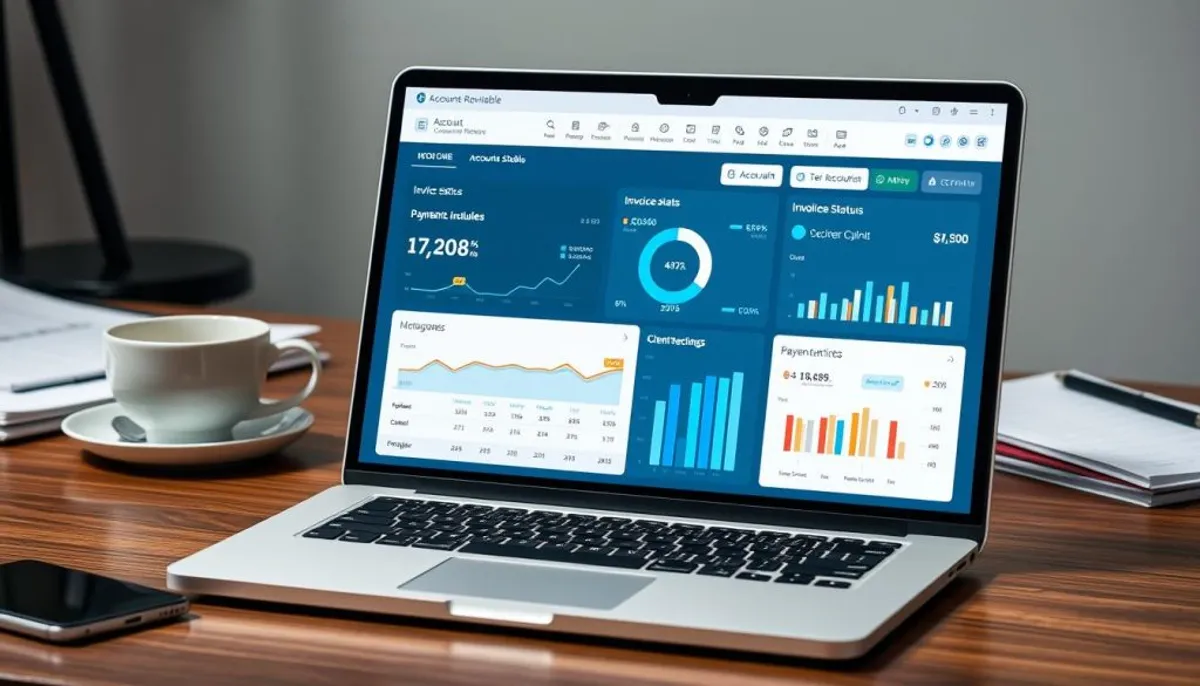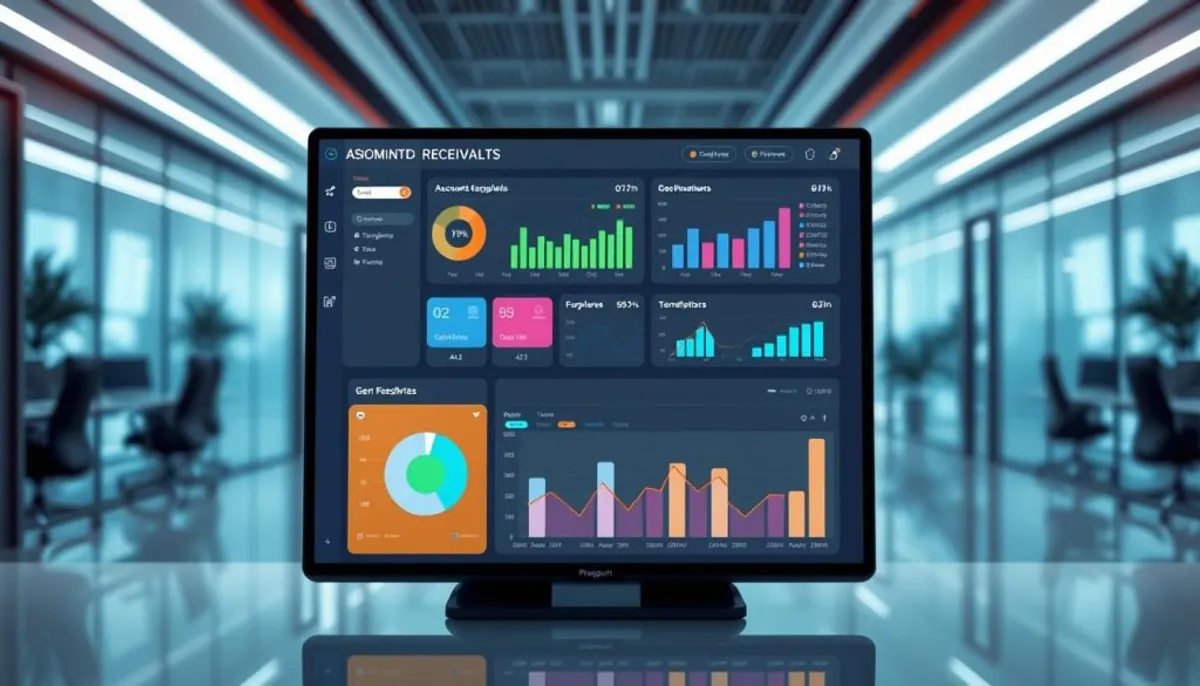Accounts receivable automation has emerged as a transformative force for businesses aiming to refine their financial operations. By leveraging the appropriate software, enterprises can significantly enhance their invoice processing and collections management. This, in turn, contributes to better cash flow and operational efficiency.

The current market presents a plethora of solutions, each tailored to address the unique needs of various businesses. Whether it’s a small team or a large corporation, there exists an AR management tool capable of overcoming specific hurdles. These platforms not only automate mundane tasks but also offer profound insights through sophisticated analytics.
Industry leaders such as Centime, Invoiced, and Tesorio are redefining the landscape. Each offers distinct functionalities, catering to a broad spectrum of business sizes and complexities. For example, Centime excels in comprehensive cash management for small to medium-sized businesses, whereas Tesorio stands out in cash forecasting for larger corporations.
Key Takeaways
- AR automation significantly reduces manual data entry errors
- Software solutions offer features like automated invoice processing and payment tracking
- Top-rated AR software includes options for businesses of all sizes
- Implementing AR automation can lead to faster payment collection
- Advanced analytics help in making data-driven financial decisions
Understanding Accounts Receivable Automation and Its Impact
Accounts receivable automation transforms traditional AR processes. It simplifies tasks such as invoice creation, payment processing, and data analysis. This innovation enhances credit control and cash flow optimization, reshaping financial management for businesses.
What is AR Automation?
AR automation employs sophisticated software to manage routine AR tasks. It replaces manual data entry with automated systems, minimizing errors and conserving time. The software also sends automated reminders to customers, accelerating payment collection.
Key Benefits of Automated AR Processes
Automating AR processes yields significant benefits:
- Reduces processing costs by over 70% through electronic invoicing
- Eliminates lockbox data capture fees
- Improves credit risk management with AI-driven tools
- Enhances customer satisfaction through self-service portals
- Fosters faster payments, enhancing Days Sales Outstanding (DSO)
Impact on Business Efficiency
AR automation profoundly enhances business efficiency. It liberates AR analysts from mundane tasks, enabling them to concentrate on strategic endeavors. This transformation empowers finance teams to become pivotal strategic partners within the organization. Real-time financial data access empowers CFOs to make swift, informed decisions, bolstering the company’s financial health.
| Metric | Before Automation | After Automation |
|---|---|---|
| Invoice Processing Time | Hours | Minutes |
| Payment Collection Speed | Slow | Fast |
| Data Accuracy | Prone to Errors | High Accuracy |
| Customer Satisfaction | Variable | Improved |
Common Challenges in Accounts Receivable Management
Businesses encounter numerous obstacles in managing their accounts receivable effectively. These hurdles can significantly affect cash flow, customer relationships, and the overall financial health of a company.
Late Payment Issues
Late payments can severely strain a company’s cash flow, leading to financial uncertainty. Astonishingly, 98% of C-level executives report that upper management handles invoice disputes and payment problems. To address this, companies are adopting proactive measures. They include sending reminders before due dates and promptly contacting customers when payments are overdue.
Manual Processing Bottlenecks
Manual AR processes are often plagued by errors and inefficiency. A significant 40% of finance leaders identify manual processes as the primary challenge in collecting payments. This inability to scale efficiently results in increased costs as companies expand. Automating complex tasks and introducing safeguards can significantly reduce errors and optimize time management.
Cash Flow Management Struggles
Effective cash flow management is essential for business success. Tools for managing customer aging and collections play critical roles in addressing this challenge. Businesses are increasingly adopting digital payment methods to streamline processes. For instance, 68% of businesses are using ACH more frequently, while 64% are increasing their use of credit cards.
| Challenge | Impact | Solution |
|---|---|---|
| Late Payments | Strained cash flow | Proactive reminders, prompt follow-ups |
| Manual Processing | Errors and inefficiency | Automation, error reduction safeguards |
| Cash Flow Management | Financial instability | Digital payment adoption, AR automation |
Introducing ti3: A Modern Solution for AR Management
In today’s fast-paced business world, managing accounts receivable can be a daunting task. Enter ti3, a cutting-edge SaaS platform designed to revolutionize AR management. This innovative solution tackles the challenges of overdue accounts with precision and efficiency.
ti3 streamlines the entire AR process, from invoicing to payment collection. Its automated reminders system ensures timely follow-ups, reducing the risk of late payments. This feature alone has shown to improve cash flow for businesses by up to 30%.

The platform’s advanced payment collection tools integrate seamlessly with existing accounting systems. This integration allows for real-time tracking of customer payments and provides valuable insights into payment patterns. Companies using ti3 have reported a 25% reduction in days sales outstanding (DSO).
| Feature | Benefit | Impact |
|---|---|---|
| Automated Reminders | Reduced Late Payments | 30% Improvement in Cash Flow |
| Payment Collection Tools | Streamlined Process | 25% Reduction in DSO |
| Real-time Analytics | Better Decision Making | 20% Increase in Collection Efficiency |
ti3’s user-friendly interface makes it easy for businesses of all sizes to adopt and implement. With its cost-effective pricing model, ti3 offers a superior alternative to traditional debt collection agencies. It preserves valuable customer relationships while achieving better results.
Essential Features of Accounts Receivable Management Software
Accounts receivable management software is equipped with critical features to streamline financial operations. These tools significantly enhance efficiency, improve cash flow, and offer valuable insights into receivables.
Automated Invoice Processing
Modern AR software automates invoice processing, reducing manual errors and ensuring timely billing. This feature saves time and improves accuracy in financial transactions.
Payment Collection and Tracking
Efficient payment collection tools help businesses monitor outstanding invoices in real-time. Automated reminders for overdue payments can significantly reduce Days Sales Outstanding (DSO) and speed up collections.
Customer Communication Tools
Effective customer management features foster strong relationships, leading to better payment behaviors. These tools enable smooth communication and help set credit limits for financial risk management.
Reporting and Analytics Capabilities
Robust reporting tools provide insights through customer aging reports and key performance indicators. These analytics help track financial health and identify areas for improvement.
| Feature | Benefit |
|---|---|
| Automated Invoicing | Reduces errors, ensures timely billing |
| Real-time Reporting | Monitors outstanding invoices, identifies issues |
| Customer Management | Improves payment behaviors, manages credit limits |
| Data Security | Protects sensitive financial information |
Top AR software solutions integrate seamlessly with existing accounting and ERP systems, enhancing overall efficiency. With strong data security measures, these tools safeguard sensitive financial information, ensuring compliance with industry regulations.
Top-Rated AR Software Solutions for 2024
In 2024, businesses face a plethora of accounts receivable management software options. These tools aim to streamline collections management and enhance financial efficiency. We will examine some of the top-rated solutions, tailored to meet diverse business requirements.
For large enterprises, Billtrust and HighRadius are notable choices. Billtrust excels in core AR automation and advanced reporting capabilities. HighRadius, on the other hand, excels in handling complex cash application processes. Mid-sized businesses often prefer Bill.com, celebrated for its user-friendly interface and collaboration tools.
Invoiced emerges as a suitable option for small teams with basic collection needs. It offers core AR automation and payment automation features. FreshBooks, a favorite among freelancers and small businesses, provides an affordable and user-friendly platform.
Centime offers a comprehensive all-in-one AR and AP solution, ideal for businesses seeking an integrated approach. Lockstep stands out for its focus on customer self-service.
| Software | Core AR Automation | Advanced Reporting | Payment Automation | Collaboration Tools | Customer Self-Service |
|---|---|---|---|---|---|
| Billtrust | ✓ | ✓ | ✓ | ||
| HighRadius | ✓ | ✓ | ✓ | ||
| Bill.com | ✓ | ✓ | ✓ | ||
| Invoiced | ✓ | ✓ | |||
| FreshBooks | ✓ |
When selecting accounts receivable management software, consider your business size, specific needs, and integration capabilities. The right solution can significantly enhance your AR processes and overall financial health.
Integration Capabilities and System Requirements
The selection of accounts receivable management software is heavily influenced by its integration capabilities. The ability to integrate with existing systems is paramount. This integration ensures seamless data exchange and enhances operational efficiency.
ERP System Compatibility
Leading AR solutions are designed to work seamlessly with prominent ERP systems, such as QuickBooks and NetSuite. This compatibility facilitates smooth data transfer, minimizing the need for manual input and reducing errors. For retail entities, the integration with POS systems is notably beneficial.
Accounting Software Integration
Integration with accounting systems is vital for maintaining precise financial records. These connections allow for instant updates of customer balances, invoices, and payments across all platforms. Such integration boosts financial transparency and report accuracy.
API Access and Customization Options
API access grants businesses the power to customize AR software to meet their specific needs. It facilitates the integration with other business tools and the development of tailored reports or automations. This adaptability is crucial for entities with intricate AR processes or unique industry requirements.

| Integration Feature | Benefit |
|---|---|
| ERP Compatibility | Streamlined data flow, reduced manual entry |
| Accounting Software Integration | Real-time financial updates, improved accuracy |
| API Access | Custom integrations, specialized reporting |
Security and Compliance Features in AR Software
AR software must prioritize data security and compliance features to protect sensitive financial information. Modern solutions offer robust measures to safeguard transactions and adhere to industry standards.
Top AR platforms implement encryption protocols to secure data during transmission and storage. They also provide user access controls, allowing businesses to manage who can view and modify financial records. Multi-tenant security measures ensure data isolation between different clients using the same software.
Compliance is crucial in AR management. Software solutions often include built-in support for various regulations:
- ISO standards for quality management
- GDPR for data protection in the EU
- SOC reporting for service organization controls
- PCI DSS for secure payment card processing
These compliance features help businesses meet legal requirements and build trust with customers. By choosing AR software with strong security and compliance capabilities, companies can protect their financial data and streamline their operations.
| Security Feature | Benefit |
|---|---|
| Encryption | Protects data from unauthorized access |
| Access Controls | Limits data exposure to authorized personnel |
| Multi-tenant Security | Isolates client data in shared environments |
| Compliance Support | Ensures adherence to industry regulations |
Pricing Models and ROI Considerations
When selecting accounts receivable management software, it’s crucial to evaluate pricing models and ROI. This evaluation is essential for making an informed decision that aligns with your business goals.
Subscription-Based Options
AR software providers often offer subscription-based pricing. These plans start at $15 per month for basic features, catering to small businesses. As your requirements expand, you can transition to more advanced plans.
Enterprise Pricing Solutions
For larger organizations, custom enterprise solutions are necessary. These solutions are priced based on specific needs, user count, and desired functionalities. Costs can range from $25,000 to $75,000 annually, reflecting the tailored nature of these offerings.
Cost-Benefit Analysis
When evaluating ROI, it’s vital to compare the software’s cost against its potential benefits:
- Time savings from automated processes
- Improved cash flow through faster collections
- Reduced errors in invoice processing
- Enhanced customer communication
| Metric | Software Vendor | In-House Solution |
|---|---|---|
| Initial Investment | $3,000 | $500,000 – $2,000,000 |
| Ongoing Costs | $25,000 – $75,000 | $250,000 – $500,000 |
| Deployment Time | 3 – 6 weeks | 8 – 12 months |
Investing in AR software can yield substantial ROI, potentially reaching up to 390%. Businesses experience a 3x increase in A/R team productivity and a 30% improvement in timely cash inflow post-implementation.
Implementation and User Training Best Practices
Introducing accounts receivable management software can revolutionize a company’s operations. Yet, success is contingent upon effective implementation and user training. Research indicates that 70% of digital transformation endeavors fail, underscoring the imperative for meticulous planning.
Optimal implementation strategies encompass three pivotal components: strategy formulation, change management, and continuous oversight. A robust strategy must articulate goals, mitigate scope creep, and delineate precise KPIs. Change management, on the other hand, necessitates effective communication, user acceptance testing, and comprehensive training.
Diverse user training methodologies exist, ranging from in-person workshops to online tutorials, user guides, and video tutorials. These tools expedite employee adaptation to new systems. Companies adopting AR solutions frequently witness expedited payment processing, enhanced ledger clarity, and augmented working capital.
Post-implementation surveillance is essential for maintaining optimal performance and scalability. It facilitates continuous refinement based on reassessed KPIs. With diligent implementation and user training, enterprises can significantly reduce cash collection time and achieve near-perfect debt recovery rates.
Adhering to these best practices enables companies to surmount typical hurdles and maximize their AR software’s capabilities. This leads to heightened visibility, enhanced productivity, and superior customer satisfaction across the enterprise.
Conclusion
Accounts receivable automation has revolutionized the way businesses manage their finances, offering significant benefits in cash flow optimization and process streamlining. With midsize organizations leveraging over 100 SaaS applications in 2024, the necessity for efficient AR management is more apparent than ever. The transition to electronic invoicing alone can liberate accounting teams from up to 60 hours of weekly tasks, showcasing the vast potential for both time and cost savings.
Automated AR systems empower companies to overcome common hurdles such as late payments, high transaction volumes, and forecasting challenges. These solutions provide a variety of electronic payment options, enhancing customer convenience and potentially increasing conversion rates. Features like autopay and automated reminders have been shown to diminish late payments, leading to more predictable cash flows.
The advantages of AR automation extend beyond mere efficiency. Given that 82% of business failures are attributed to poor cash management, the significance of robust AR practices is undeniable. E-invoicing can cut costs by up to 39%, while automation tools can reclaim as many as 25,000 hours lost to unnecessary rework. These enhancements not only optimize internal processes but also strengthen customer relationships through enhanced communication and clear expectations.
As technology advances, the role of accounts receivable automation in financial management will become even more vital. By selecting the appropriate solution that integrates smoothly with existing systems and offers customization options, businesses can set themselves up for strategic growth and financial success in a highly competitive market.
RelatedRelated articles



